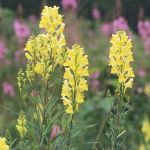| Common Name: |
Butter-and-eggs |
| Other Names: |
Toadflax |
| Botanical Name: |
Linaria vulgaris |
| Genus: |
Linaria |
| Family: |
Scrophulariaceae |
| Native Location: |
Europe (except extreme N and Mediterranean) |
| Cultivation: |
Well-drained, neutral to alkaline soil in sun or partial shade. Invasive. |
| Propagation: |
By seed sown in spring; by division in spring. Self-sows freely. |
| Harvest: |
Plants are cut when flowering and dried for use in infusions. |
| Height: |
15-90cm (6-36in) |
| Width: |
30-45cm (12-18in) |
| Hardiness: |
Z6-9 |
| Parts Used: |
Whole Plant |
| Properties: |
A bitter, acrid, astringent herb that cleanses toxins from the tissues, and is diuretic and laxative. It acts mainly on the liver. |
| Medicinal Uses: |
Internally for skin diseases, enteritis, hepatitis, gall bladder complaints, and edema. Not given to pregnant women. Externally for hemorrhoids, skin eruptions, sores, and malignant ulcers. |
| Warning: |
For use by qualified practioners only; dosage is critical. |
| Bibliography: |
Encyclopedia of Herbs by Deni Brown Copyright © 1995, 2001 Dorling Kindersley Limited Pp 262-263 |

